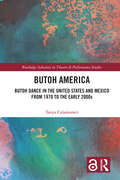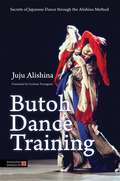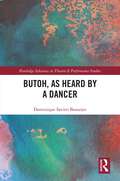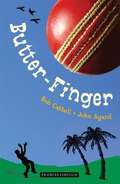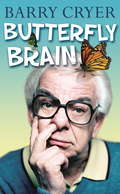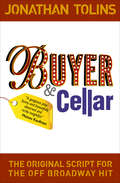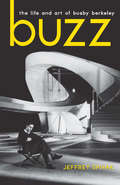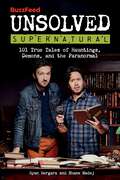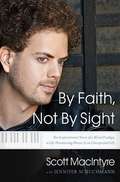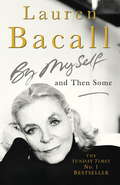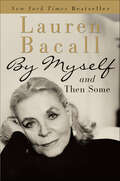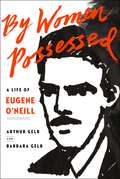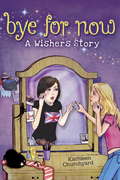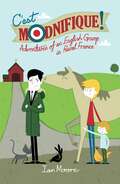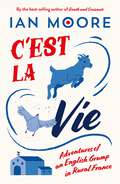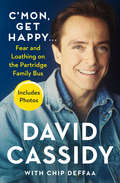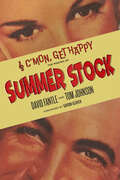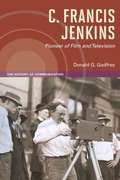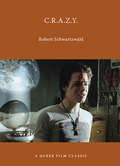- Table View
- List View
Butoh America: Butoh Dance in the United States and Mexico from 1970 to the early 2000s (Routledge Advances in Theatre & Performance Studies)
by Tanya CalamoneriButoh America unearths the people and networks that popularized Butoh dance in the Americas, through a focused look at key artists, producers, and festivals in United States and Mexico. This is the first book to gather these histories into one narrative and look at the development of American Butoh. From its inception in San Francisco in 1976, American Butoh aligned with avant-garde performance art in alternative venues such as galleries and experimental theaters. La MaMa in New York and the Festival Internacional Cervantino in Guanajuato both served to legitimize the form as esteemed experimental performance. A crystalizing moment in each of the three locations—San Francisco, New York, and Mexico City—has been a grand-scale festival featuring prominent Japanese and numerous other international artists, as well as fostering local communities. This book stitches together the flow of people and ideas, highlights the connections in the Butoh diaspora, and incorporates interviewee perspectives regarding future directions for the genre in the Americas.
Butoh Dance Training: Secrets of Japanese Dance through the Alishina Method
by Juju Alishina Corinna TorregianiDrawing on avant garde and classical Japanese dance traditions, the Alishina Method offers a systematized approach to Butoh dance training for the first time in its history. With practical instruction and fully illustrated exercises, this book teaches readers: · basic body training and expression exercises · exercises to cultivate Qi (energy) and to aid improvisation · about katas (forms) and how to develop your own · the importance of voice, sound and music in Butoh · to collaborate and be in harmony with others · techniques to manipulate time and space · how to develop the imagination and refine the senses to enrich performance. This authentic approach to Japanese dance will be compelling reading for anyone interested in contemporary dance, performance arts, Japanese culture or personal development techniques.
Butoh, as Heard by a Dancer (Routledge Advances in Theatre & Performance Studies)
by Dominique Savitri BonarjeeThis book explores the origins of Butoh in post-war Japan through orality and transmission, in conjunction with an embodied research approach. The book is a gathering of seminal artistic voices – Yoshito Ohno, Natsu Nakajima, Yukio Waguri, Moe Yamamoto, Masaki Iwana, Ko Murobushi, Yukio Suzuki, Takao Kawaguchi, Yuko Kaseki, and the philosopher, Kuniichi Uno. These conversations happened during an extended research trip I made to Japan to understand the context and circumstances that engendered Butoh. Alongside these exchanges are my reflections on Butoh’s complex history. These are primarily informed by my pedagogical and performance encounters with the artists I met during this time, rather than a theoretical analysis. Through the words of these dancers, I investigate Butoh’s tendency to evade categorization. Butoh’s artistic legacy of bodily rebellion, plurality of authorship, and fluidity of form seems prescient and feels more relevant in contemporary times than ever before. This book is intended as a practitioner's guide for dancers, artists, students, and scholars with an interest in non-Western dance and dance history, postmodern performance, and Japanese arts and culture.
Butter-Finger
by Bob Cattell John AgardButter-Finger follows the story of Riccardo Small, who misses a vital catch and is dropped from the cricket team. Riccardo takes refuge in his beloved calypso poems, written by John Agard, when he meets Count Crayfish, who helps him think of a way to still help the team. Ages 7 and up.
Butterfly Brain
by Barry CryerBarry Cryer is one of the great comedians of the last 50 years. This is a sparkling series of hilarious and true anecdotes, almost all of which have never been told before!Barry Cryer has collaborated with all the greats from Max Miller to Tony Hancock, Bob Hope, Peter Cook and Dudley Moore, John Cleese, Frankie Howerd, Kenny Everett, Spike Milligan, Eric Sykes, Dave Allen, Richard Pryor, Tommy Cooper, Les Dawson, Graham Chapman, the Two Ronnies, Morecambe and Wise - in fact almost all the great comedians and comic writers since the mid 1950s. Barry's set of experiences with these legends of humour is unique, and will delight all who made PIGS CAN FLY a runaway porcine bestseller.In this completely new, organically grown book, old Baz recalls, reminisces, recounts and other words beginning with 'R', on a trip down Memory Lane, pausing only for tea and macaroons at the Stannah Stairlift Cafe. What memories - if only he can remember them. Currently 74, a third of his life has already passed and he invites you to enjoy this wonderfully funny account of it, a decorous orgy of nostalgia.
Butterfly Brain
by Barry CryerBarry Cryer is one of the great comedians of the last 50 years. This is a sparkling series of hilarious and true anecdotes, almost all of which have never been told before!Barry Cryer has collaborated with all the greats from Max Miller to Tony Hancock, Bob Hope, Peter Cook and Dudley Moore, John Cleese, Frankie Howerd, Kenny Everett, Spike Milligan, Eric Sykes, Dave Allen, Richard Pryor, Tommy Cooper, Les Dawson, Graham Chapman, the Two Ronnies, Morecambe and Wise - in fact almost all the great comedians and comic writers since the mid 1950s. Barry's set of experiences with these legends of humour is unique, and will delight all who made PIGS CAN FLY a runaway porcine bestseller.In this completely new, organically grown book, old Baz recalls, reminisces, recounts and other words beginning with 'R', on a trip down Memory Lane, pausing only for tea and macaroons at the Stannah Stairlift Cafe. What memories - if only he can remember them. Currently 74, a third of his life has already passed and he invites you to enjoy this wonderfully funny account of it, a decorous orgy of nostalgia.
Buyer & Cellar: The Original Script for the Off Broadway Hit
by Jonathan TolinsThe original script of the award-winning off-Broadway play—&“irresistibly entertaining [and] surprisingly moving&” (Paul Rudnick). Alex More has a story to tell. A struggling actor in LA, he takes a job working in the Malibu basement of a beloved megastar. One day, the Lady Herself comes downstairs to play. It feels like real bonding in the basement—but will their relationship ever make it upstairs? A winner of the Lucille Lortel Award for Outstanding Solo Show, Buyer & Cellar is an outrageous comedy about the price of fame, the cost of things, and the oddest of odd jobs. &“Jonathan Tolins has concocted an irresistible one-man play from the most peculiar of fictitious premises . . . This seriously funny slice of absurdist whimsy creates the illusion of a stage filled with multiple people, all of them with their own droll point of view.&” —The New York Times &“A gorgeous play: funny and beautifully observed and richly insightful.&” —Moisés Kaufman &“Tolins&’s writing is smart, sharp, and hilarious—and he paints a vivid picture that even a perfectionist like Barbra would have to applaud.&” —James Lapine
Buzz: The Life and Art of Busby Berkeley (Screen Classics)
by Jeffrey SpivakA biography of the director and choreographer who kept America entertained through the Great Depression: &“[A] fascinating read.&” —Playbill Characterized by grandiose song-and-dance numbers featuring ornate geometric patterns and mimicked in many modern films, Busby Berkeley&’s unique artistry is as recognizable and striking as ever. From his years on Broadway to the director&’s chair, Berkeley is notorious for his inventiveness and signature style. Through sensational films like 42nd Street, Gold Diggers of 1933, Footlight Parade, and Dames, Berkeley sought to distract audiences from the troubles of the Great Depression. But while his bold technique is familiar to millions of moviegoers, Berkeley&’s life remains a mystery. Buzz: The Life and Art of Busby Berkeley is a telling portrait of the filmmaker who revolutionized the musical and changed the world of choreography. Berkeley pioneered many conventions still in use today, including the famous &“parade of faces&” technique, which lends an identity to each anonymous performer in a close-up. Carefully arranging dancers in complex and beautiful formations, Berkeley captured perspectives never seen before. Jeffrey Spivak&’s meticulous research magnifies the career and personal life of this beloved filmmaker. Employing personal letters, interviews, studio memoranda, and Berkeley&’s private memoirs, Spivak unveils the colorful life of one of cinema&’s greatest artists.
BuzzFeed Ultimate Book of Quizzes: Questions and Answers on Life, Love, Food, Friendship, TV, Movies, and More
by BuzzFeedHilarious, entertaining, and irresistibly binge-worthy, this officially licensed ultimate collection of BuzzFeed quizzes -- from the most popular to the never-before-published -- includes hundreds of questions on everything you love all in one place!If you've been on the internet, chances are you've taken a BuzzFeed quiz or three in your lifetime. And if so, you probably know which Friends character you are or what your favorite fruit says about you. For years, BuzzFeed quizzes have made the rounds online and have gone crazy viral for a good reason -- they're fun, interactive, and super shareable. For the first time ever, BuzzFeed brings you one jam-packed book overflowing with 200 quizzes covering love, food, friendship, TV, movies, personality, and everything under the pop-culture sun. So whether you want to know which Disney character is your soul mate, where you should go on your next vacation, or what age you really are, gather your closest friends, break out the gel pens, and crack this quiz book open to find out.
BuzzFeed Unsolved Supernatural: 101 True Tales of Hauntings, Demons, and the Paranormal
by BuzzFeed Ryan Bergara Shane MadejBased off one of the most popular web series on the internet, Ryan Bergara and Shane Madej present BuzzFeed Unsolved Supernatural, 101 of the scariest, spookiest, and creepiest locations around the USA and a few abroad, with 50 percent brand-new content and locales exclusive to the book.Hey there, demons! BuzzFeed Unsolved Supernatural has entertained viewers over the course of seven spooky seasons, covering the supernatural and otherworldly spirits, to ghosts, ghouls, unexplained paranormal activity, and everything in between. In their thrilling debut book, cohosts Shane Madej and Ryan Bergara (lovingly known as the &“ghoul boys&” to fans) deep-dive into dozens of haunted locations around the USA and a few abroad, including subjects from some of their most favorite and talked about episodes, as well as brand-new locations not previously seen before on their show. As they explore the history behind haunted houses, creepy graveyards, former insane asylums, abandoned buildings, and horrifying hotels, Shane and Ryan use their trademark wit and humor to dissect each terrifying tale with their most hilarious highlights and biting commentary. So hold on to your hell-bound soul, boys and ghouls—it&’s about to get demonic up in here.
By Faith, Not By Sight: The Inspirational Story of a Blind Prodigy, a Life-Threatening Illness, and an Unexpected Gift
by Scott Macintyre Jennifer SchuchmannA moving story of hope, faith, persistence and the power of dreams. In By Faith, Not by Sight, American Idol's first ever disabled finalist Scott MacIntyre shares his inspiring story of being a musical and academic prodigy who prevails over life-threatening obstacles to become a pop sensation. When stage four renal failure tries to stop his dream of studying classical piano in London, Scott bravely moves forward and finds new friendships and freedom despite his blindness. Then when his kidney transplant, a painful recovery, and his sister's kidney transplant all attempt to sideline him once more, he perseveres and makes it to the top ten finale of American Idol. Scott defies all odds: having to dance on stage, always having a sighted guide with him, and still singing with sound monitors that quit working. Despite so many obstacles, he goes on tour with the Idol cast, records an album (Heartstrings), and finds love for the first time. Through an unwavering faith in God and himself, Scott teaches all of us that our dreams are possible regardless of our circumstances. Though he can't see the world around him, he has always been able to see his dreams and pursues them fearlessly.
By Myself and Then Some
by Lauren BacallLauren Bacall was barely 20 when she made her Hollywood debut with Humphrey Bogart and became an overnight sex symbol. Their romance on and off screen made them Hollywood's most celebrated couple and together they produced some of the most electric scenes in movie history. But when Bogart died of cancer in 1957, Bacall had to find a way of living beyond the fairytale. In a time of post war communism, Hollywood blacklisting and revolutionary politics she moved with the legends: Hemingway, the Oliviers, Katharine Hepburn, Bobby Kennedy, an engagement to Frank Sinatra and a second turbulent marriage to Jason Robards. Now in her eighties, BY MYSELF AND THEN SOME brings her story up to date including her recent films and Broadway runs, fond memories of her many close lifelong friendships, not least the greatest love of her life, Humphrey Bogart.
By Myself and Then Some
by Lauren BacallThe epitome of grace, independence, and wit, Lauren Bacall continues to project an audacious spirit and pursue on-screen excellence. The product of an extraordinary mother and a loving extended family, she produced, with Humphrey Bogart, some of the most electric and memorable scenes in movie history. After tragically losing Bogart, she returned to New York and a brilliant career in the theatre. A two-time Tony winner, she married and later divorced her second love, Jason Robards, and never lost sight of the strength that made her a star.Now, thirty years after the publication of her original National Book Award–winning memoir, Bacall has added new material to her inspiring history. In her own frank and beautiful words, one of our most enduring actresses reveals the remarkable true story of a lifetime so rich with incident and achievement that Hollywood itself would be unable to adequately reproduce it.
By Women Possessed: A Life of Eugene O'Neill
by Arthur Gelb Barbara GelbCelebrated for their books on Eugene O'Neill and enjoying access to a trove of previously sealed archival material, the Gelbs deliver their final volume on the stormy life and brilliant oeuvre of this Nobel Prize-winning American playwright. This is a tour through both a magical moment in American theater and the troubled life of a genius. Not a peep show or a celebrity gossip fest, this book is a brilliant investigation of the emotional knots that ensnared one of our most important playwrights. Handsome, charming when he wanted to be: O'Neill was the flame women were drawn to--all, that is, except his mother, who never let him forget he was unwanted. By Women Possessed follows O'Neill through his great successes, the failures he was able to shrug off, and the long eclipse, a twelve-year period in which, despite the Nobel, nothing he wrote was produced. But ahead lay his greatest achievements: The Iceman Cometh and Long Day's Journey into Night. Both were ahead of their time and both received lukewarm receptions. It wasn't until after his death that his widow, the keeper of the flame, began a fierce and successful campaign to restore his reputation. The result is that today, just over 125 years after his birth, O'Neill is a towering presence in the theater, his work--always in performance here and abroad--still electrifying audiences. Perhaps of equal importance, he is the acknowledged father of modern American theater, the man who paved the way for the likes of Arthur Miller, Tennessee Williams, Edward Albee, and a host of others. But, as Williams has said, at a cost: "O'Neill gave birth to the American theater and died for it."From the Hardcover edition.
By Your Side: My Life Loving Barbara Windsor
by Scott MitchellA warm, colourful and heartfelt tribute to Barbara Windsor's rich, varied and remarkable life from the man who knew her best.'I'm so glad you had the life you did, Barbara. I'm sorry you can't remember, but my God, what a life! You haven't wasted a minute of it...'In December 2020, while the world was gripped with news of an imminent third lockdown, Scott Mitchell was visiting the care home where his partner and wife of 27 years - Dame Barbara Windsor - was being looked after. At the age of 83, after a career spanning seven decades and a seven-year battle with the debilitating effects of dementia, she was slipping away.Barbara's illness meant she could no longer remember her magical career, and so Scott sat by her bedside in her final days, telling her tales from their extraordinary life together. From the unlikely moment they met to the challenges they faced, and the highs and lows of a life shared in the limelight. For theirs was an incredibly passionate relationship, but also a turbulent one - and along with a life of love and laughter, together they endured the pressures of fame, drink and addiction, heartbreak and ultimately dementia. He told Barbara stories of her wonderful achievements on and off screen, and the people who altered the trajectory of her life. From nine enormously successful and much-loved Carry On films to more than twenty years in Albert Square with the role of Peggy Mitchell. From director Joan Littlewood handpicking her for Sparrows Can't Sing and her first husband Ronnie Knight and his links to the Kray twins, to her friendships with Sid James, Kenneth Williams and more.Weaving together an old-fashioned love story, a glittering life of showbiz and the true cost of dementia, By Your Side is a treasure trove for all of us who grew up watching and loving Dame Barbara. From the madness and the mayhem, the glorious highs and the devastating lows, to the fantastic fun she and Scott had along the way - this is an intimate, honest and incredibly personal account of a life spent loving Babs.
By Your Side: My Life Loving Barbara Windsor
by Scott MitchellA warm, colourful and heartfelt tribute to Barbara Windsor's rich, varied and remarkable life from the man who knew her best.'I'm so glad you had the life you did, Barbara. I'm sorry you can't remember, but my God, what a life! You haven't wasted a minute of it...'In December 2020, while the world was gripped with news of an imminent third lockdown, Scott Mitchell was visiting the care home where his partner and wife of 27 years - Dame Barbara Windsor - was being looked after. At the age of 83, after a career spanning seven decades and a seven-year battle with the debilitating effects of dementia, she was slipping away.Barbara's illness meant she could no longer remember her magical career, and so Scott sat by her bedside in her final days, telling her tales from their extraordinary life together. From the unlikely moment they met to the challenges they faced, and the highs and lows of a life shared in the limelight. For theirs was an incredibly passionate relationship, but also a turbulent one - and along with a life of love and laughter, together they endured the pressures of fame, drink and addiction, heartbreak and ultimately dementia. He told Barbara stories of her wonderful achievements on and off screen, and the people who altered the trajectory of her life. From nine enormously successful and much-loved Carry On films to more than twenty years in Albert Square with the role of Peggy Mitchell. From director Joan Littlewood handpicking her for Sparrows Can't Sing and her first husband Ronnie Knight and his links to the Kray twins, to her friendships with Sid James, Kenneth Williams and more.Weaving together an old-fashioned love story, a glittering life of showbiz and the true cost of dementia, By Your Side is a treasure trove for all of us who grew up watching and loving Dame Barbara. From the madness and the mayhem, the glorious highs and the devastating lows, to the fantastic fun she and Scott had along the way - this is an intimate, honest and incredibly personal account of a life spent loving Babs.
Bye For Now: A Wishers Story
by Kathleen ChurchyardThe candles dripped onto the icing as Robin deliberated. What could she possibly wish? She wanted to wake up the next day and learn all her problems were gone. But since her problems weren’t going to disappear, she didn’t want to be Robin anymore. “I wish I was somebody else,” Robin wished. And in that moment, she meant it. She blew out the candles. After the worst eleventh birthday ever, Robin wakes up the next morning in the body of Fiona, an eleven-year-old girl from London with an amazing life. Fiona is gorgeous, with glamorous parents, and she’s the star of a major theatrical production. Why would Fiona have wished herself out of her own body? Slowly, Robin discovers a whole network of girls like her-girls who have gotten their wish and are living somebody else’s life. But what happens when Robin finally decides she wants to go home? Does anybody in the Wishers network know how to make this happen? In this exciting first novel, Kathleen Churchyard asks: What if you wished for someone else’s life-and it came true?
C'est Modnifique!: Adventures of an English Grump in Rural France
by Ian MooreAfter six years in the idyllic Loire Valley, comedian Ian Moore, his family and his growing menagerie feel like they’re on the cusp of the peace they hoped for. Their grand project, a writing school, is complete – only, nobody’s signed up. The Moores have their work cut out – but they’re determined to give it their best shot!
C'est Modnifique!: Adventures of an English Grump in Rural France
by Ian MooreAfter six years in the idyllic Loire Valley, comedian Ian Moore, his family and his growing menagerie feel like they’re on the cusp of the peace they hoped for. Their grand project, a writing school, is complete – only, nobody’s signed up. The Moores have their work cut out – but they’re determined to give it their best shot!
C'est la Vie: Adventures of an English Grump in Rural France
by Ian MooreFollow the misadventures of Ian Moore as he chronicles the charming and chaotic escapades of his family and their eccentric assembly of animals, on their continued search for serenity in rural France. With stresses, strains and animal poo mounting up, la famille Moore have their work cut out - but they're determined to give it their best shot!
C'mere and I Tell Ya: The 2 Johnnies Guide to Irish Life
by Johnny O'Brien Johnny McMahonThe 2 Johnnies' massive success has taken them as far afield as Sydney, Compton and Abu Dhabi. But for them nothing compares to living in Ireland. And in C'Mere and I Tell Ya they dig into the tastes, habits and rites of passage that have made them who they are.Whether it's ... - dressing for the debs ('I'd say my cravat was the talk of Templemore for weeks') - succeeding in a band ('I did backing vocals for six months and it turned out I was singing the wrong lyrics') - doing a Strictly fundraiser for your GAA club ('Remember you're not Julia Roberts and the local butcher isn't Richard Gere, so keep it in the pants') - recognizing the no-go moves at a stag ('Nobody wants to see a sixteen-stone man in a pink thong. Nobody')... Johnny B and Johnny Smacks capture it perfectly. And they have down-to-earth advice for every conceivable situation - and a few inconceivable ones.C'Mere and I Tell Ya is a one-stop celebration of Irishness, chicken goujons and being sound.'It's funny but there is always truth in the humour ... A hell of a Christmas present!' Oliver Callan, RTÉ
C'mon, Get Happy . . .: Fear and Loathing on the Partridge Family Bus
by David Cassidy Chip DeffaaThis memoir by David Cassidy tells the real story behind his phenomenal ’70s stardom—and the sadness that shadowed it. Includes photos and a new afterword. Barely out of his teens, David Cassidy landed a role on a new sitcom about a musical family that toured in a psychedelic bus. The critics blasted it—but TV viewers loved it! And the young female audience especially loved Keith Partridge. Not only did they tune in each week, they bought The Partridge Family’s hit single, “I Think I Love You,” in the millions, and plastered David’s image on their bedroom walls. Throughout the early seventies, David Cassidy was a phenomenon. In this wry, witty memoir, he recounts not only those wild youthful years and Hollywood relationships—with, among others, stepmom Shirley Jones, costar Susan Dey, actress Meredith Baxter, and two guest stars who soon found greater fame on Charlie’s Angels—but also the darker parts of his life as well. David delves into his painful family history and his childhood in West Orange, New Jersey, and the groupies and drugs he indulged in as his success began to overwhelm him. He also shares his encounters with the icons of the era—Lennon and McCartney, Elvis, the Beach Boys, and more. Most of all, he takes us back to a time when the world seemed more innocent—at least until the camera stopped rolling. Includes a new afterword about David’s final years by friend and coauthor Chip Deffaa. “A chatty read about becoming an overnight success and all the trappings that came with it: Tiger Beat magazine, sold-out stadium shows, hit records, willing girls in every hotel lobby.” —Star Tribune
C'mon, Get Happy: The Making of Summer Stock
by Tom Johnson David FantleIn their third and final screen teaming, Judy Garland and Gene Kelly starred together in the MGM musical Summer Stock. Despite its riveting production history, charismatic lead actors, and classic musical moments, the movie has not received the same attention as other musicals from MGM’s storied dream factory. In C’mon, Get Happy: The Making of “Summer Stock,” authors David Fantle and Tom Johnson present a comprehensive study of this 1950 motion picture, from start to finish and after its release.The production coincided at a critical point in the careers of Kelly and an emotionally spent Garland. Kelly, who starred in An American in Paris just one year later, was at the peak of his abilities. On the other hand, Summer Stock was Garland’s final film at MGM, and she gamely completed it despite her own personal struggles. Summer Stock includes Kelly’s favorite solo dance routine and Garland’s signature number “Get Happy.”The authors discuss in rich detail the contributions of the cast (which included Gloria DeHaven, Eddie Bracken, Phil Silvers, and Marjorie Main); the director (Charles Walters); the producer (Joe Pasternak); the script writers (George Wells and Sy Gomberg); the songwriters (which included Harry Warren and Mack Gordon); and top MGM executives (Louis B. Mayer and Dore Schary). The volume features extensive interviews, conducted by the authors, with Kelly, Walters, Warren, and others, who shared their recollections of making the movie. Deeply researched, C’mon, Get Happy reveals the studio system at work during Hollywood’s Golden Era.Additionally, the authors have written a special section called “Taking Stock” that buttonholes numerous contemporary dancers, singers, choreographers, musicians, and even Garland impersonators for their take on Summer Stock, its stars, and any enduring legacy they think the film might have. Artists from Mikhail Baryshnikov, Ben Vereen, and Tommy Tune to Garland’s and Kelly’s daughters, Lorna Luft and Kerry Kelly Novick, respectively, offer their unique perspective on the film and its stars.
C. Francis Jenkins, Pioneer of Film and Television
by Donald G. GodfreyThis is the first biography of the important but long-forgotten American inventor Charles Francis Jenkins (1867-1934). Historian Donald G. Godfrey documents the life of Jenkins from his childhood in Indiana and early life in the West to his work as a prolific inventor whose productivity was cut short by an early death. Jenkins was an inventor who made a difference. As one of America's greatest independent inventors, Jenkins's passion was to meet the needs of his day and the future. In 1895 he produced the first film projector able to show a motion picture on a large screen, coincidentally igniting the first film boycott among his Quaker viewers when the film he screened showed a woman's ankle. Jenkins produced the first American television pictures in 1923, and developed the only fully operating broadcast television station in Washington, D.C. transmitting to ham operators from coast to coast as well as programming for his local audience. Godfrey's biography raises the profile of C. Francis Jenkins from his former place in the footnotes to his rightful position as a true pioneer of today's film and television. Along the way, it provides a window into the earliest days of both motion pictures and television as well as the now-vanished world of the independent inventor.
C.R.A.Z.Y.: A Queer Film Classic
by Robert SchwartzwaldA Queer Film Classic on the 2005 film debut by French-Canadian director Jean-Marc Vallée (best known for Dallas Buyers Club and Wild), about a young gay man who struggles to find his sense of self amidst a "crazy" family of four brothers and a homophobic father who seeks to cure him. The film won a best picture Genie Award (Canada's version of the Oscars) in 2006.Robert Schwartzwald in a professor at the Université de Montréal.
